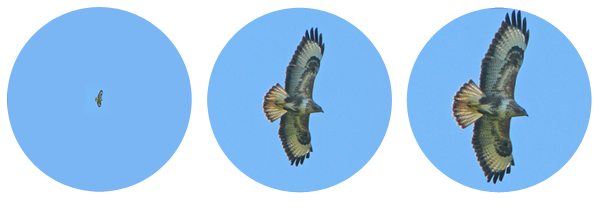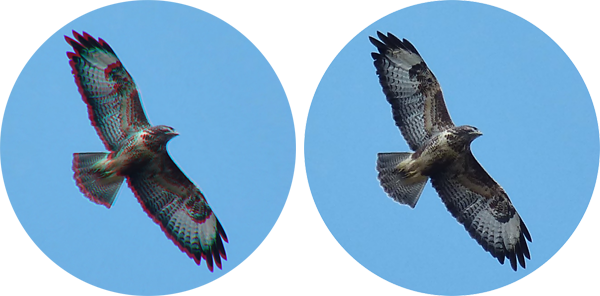
Sales and Advice:
01580 880803
Tues - Sat: 9am - 5pm
Sunday: 10am - 4pm
Monday: Closed
After the model name of a pair of binoculars often comes a set of numbers such as 8x25 or 10x42. The first figure is used to describe the magnification and the second is the objective lens diameter measured in mm. Using the two figures, you can calculate the exit pupil (how much light the binoculars can gather). A pair of binoculars might also list their field of view. Below I will explain further what these terms mean.
The image below shows a Buzzard without binoculars, then what you see with 8x magnification and finally with 10x.

Although higher magnification binoculars have their obvious advantages, generally they let in less light therefore producing a slightly duller image. 8x and 10x are the two most popular magnifications, but it is important to try the different magnifications before you choose as each individual will have different preferences. You need to decide whether the extra reach of the 10x outweighs the larger field of view (see below) and extra light gathered by the 8x. Other fixed magnifications are available (6x, 7x, 12x etc) and zoom binoculars (10-40x) are also available, 8x and 10x offer the best all round performance.
 This is simply the width of the lens that you're not looking through!
The larger the diameter of the objective lens, the more light the binoculars are able to gather. However, as a rule of thumb, the physical attributes of the binoculars are affected by the
diameter of the objective lens - the wider the diameter, the heavier (and larger) the binoculars. Before you buy your binoculars, decide what is more important; having a compact,
lightweight pair or a brighter image. You may decide something in between suits you best; nowadays 32mm objective lens diameter binoculars are becoming more popular,
offering a perfect compromise between the portability of a compact pair and the capability of a larger pair.
This is simply the width of the lens that you're not looking through!
The larger the diameter of the objective lens, the more light the binoculars are able to gather. However, as a rule of thumb, the physical attributes of the binoculars are affected by the
diameter of the objective lens - the wider the diameter, the heavier (and larger) the binoculars. Before you buy your binoculars, decide what is more important; having a compact,
lightweight pair or a brighter image. You may decide something in between suits you best; nowadays 32mm objective lens diameter binoculars are becoming more popular,
offering a perfect compromise between the portability of a compact pair and the capability of a larger pair.
As discussed, the magnification and objective lens diameter determine how much light is transmitted to your eye. The official term used to describe this is Exit Pupil, which can be easily calculated by dividing the objective lens diameter by the magnification. Using 8x42 as an example, divide 42 by 8 to get your exit pupil, which here would be 5.25mm. From an 8x32 pair, the figure drops to 4mm and finally on a 10x25, the exit pupil is a mere 2.5mm wide. In bright, sunny conditions this figure isn't hugely important as often your pupils will be dilated around 2-3mm, often equal or less than the exit pupil of your binoculars. However, as the ambient light dims, your pupils adapt to the light by enlarging in size (up to 8mm), therefore the exit pupil of your binoculars can become a limiting factor. When considering your purchase, think about how often you intend to use you binoculars and at what time of day/year. If you think you'll often be using them at dawn, dusk and in the darker winter months, choose a pair that offers a large exit pupil.
Another important factor to consider when purchasing a pair of binoculars is the field of view. As a rule of thumb, the wider the degree, the better, though again it's best to test or read reviews on any pair you're considering, as they may offer a wide field of view but struggle with softening and distortion at the edges. A wide field of view allows for easy 'track and trace' birdwatching, whereby you can easily find a bird and follow its movements.
Take a look at the image below, for example. When standing 1000m away from a scene, the image produced by a pair of binoculars with a 6° field of view will be 105m wide. If they're 7° you'll see 122.5m and with an 8° field of view you'll see 140m of that scene.

Just to confuse you, some brands lists their field of view figures as an angle and others as a distance at 1000 metres or yards. Because we like to be helpful we've created a table to help you convert common field of view figures from one to another. As a very rough guide, you can convert your figure in degrees to a m@1000m figure by multiplying by 17.5x, and multiplying again by 3x to give you ft@1000yds.
| Degrees | m@1000m | ft@1000yds |
|---|---|---|
| 4.0 | 70.0 | 210.0 |
| 4.5 | 78.8 | 236.3 |
| 5.0 | 87.5 | 262.5 |
| 5.5 | 96.3 | 288.8 |
| 6.0 | 105.0 | 315.0 |
| 6.5 | 113.8 | 341.3 |
| 7.0 | 122.5 | 367.5 |
| 7.5 | 131.3 | 393.8 |
| 8.0 | 140.0 | 420.0 |
| 8.5 | 148.8 | 446.3 |
| 9.0 | 157.5 | 472.5 |
Most binoculars will feature some sort of coating on their lenses. The coatings are designed to reduce reflections and increase light transmission. There are numerous different coatings available:
Coated - a single layer of anti-reflective coating on one or more of the lenses.
Fully Coated - all of the lens elements have a single coating.
Multi-coated - one or more of the lenses have numerous anti-reflective coatings.
Fully Multi-coated - All of the lens elements have received multiple layers of coatings.
Fully multi-coated is nowadays commonplace on binoculars above £100, meaning the minimum amount of light is lost when passing through each air-to-glass surface. Typically a pair of binoculars contains anywhere between 5 and 10 lenses, so 10 to 20 surfaces. The very best anti-reflective coatings can reduce light lost at each surface from 5% to just 0.2%.
The design of most roof prism binoculars mean mirror coatings also need to be applied to ensure a high reflectivity on the internal mirrors, thus when coupled with anti-reflective coatings will maximise light transmission.
Most budget binoculars feature aluminium mirror coatings (87% to 93% reflectivity), some with silver coatings (95% to 98% reflectivity) and more expensive instruments can utilize dielectric mirror coatings,
the very best of which can provide a reflectivity of more than 99%.
Note: Some manufacturers have their own names for coatings, e.g. Opticron's "Oasis Prism Coating", which is their term for 64-layer dielectric mirror coating.
Further to lens coatings, phase correction improves the overall image clarity and sharpness produced by the binoculars. Due to the design of roof prism binoculars, light waves are
reflected at the opposite faces causing 'phase shift', which reduces the contrast and resolution. This interference is suppressed by PC (phase correction) coatings, therefore
phase corrected binoculars will produce a better picture than those without.
Note: PC coatings aren't required in Porro Prism binoculars.
ED binoculars contain Extra-low Dispersion glass, which reduces or eliminates chromatic aberration (CA). In certain light conditions, colour fringing can occur on the edges of an object, reducing the clarity of the picture. Often this phenomenon is most noticable at the periphery of the view, and is also more obvious in higher magnification binoculars. The image below illustrates how ED binoculars (right) improves the picture when compared to non-ED binoculars (left).

Once you have purchased your binoculars, you need to adjust the dioptre so the barrels are aligned to your eyes.
First of all, cover up the right lens with the objective lens cover and then, using the central focus wheel, focus on an object somewhere between close focus and infinity. Once focussed, uncover the right objective lens and cover the left side. Making sure you don't move where you're standing, using the dioptre adjustment (often found next to the right eye piece or attached to the central focus wheel), ensure the picture is focussed to suit your right eye. Sometimes you won't need to turn the dioptre, but if the image is even just a little bit blurry, move the dioptre until the image is perfect. When you're happy, uncover the objective lens and check the image is aligned.
You won't need to do this again unless the dioptre is moved by accident or if someone else adjusts it.
Yes! Keeping your binoculars clean will ensure a clear, bright image. Most binoculars are supplied with a cleaning cloth, but it can be a good idea to purchase lens cleaning wipes or optics cleaning fluid. Some mid to high end binoculars have special coatings applied to the exterior lenses to help shed water and dirt, making for easier cleaning and offering better protection from accidentally scratching the lens. Look for hydrophobic coatings or SWAROCLEAN technology.
The SWAROVISION technology redefined the concept of optical quality. Field Flattener lenses provide unprecedented peripheral definition, fluoride-containing HD lenses minimize color fringing, while optimized coatings ensure maximum color fidelity. Large eye relief offering a full field of view for those wearing eye glasses.
Our HD optics feature fluoride-containing lenses, which virtually eliminate color aberrations. The scatter is considerably less with fluoride than with even the best types of optical glass. This enables maximum color fidelity and leads to a significant improvement in resolution and contrast.
Coating for maximum color fidelity across the whole light spectrum: SWAROVSKI OPTIK was the first manufacturer in the world to use this technology in series production.
Coatings for bright, high-contrast images: Reduces surface light reflection from 4-6% to 0.2%. Used on all the lenses and prisms found in SWAROVSKI OPTIK products.
This non-stick coating on the lenses makes it easier to clean away dirt such as water marks, insect repellents, or tree resin.
Phase-corrected coating used in all types of roof-prism glass for high-contrast images.
Wrap-around grip used on all EL binoculars, permitting optimum, rapid handling with just one hand.